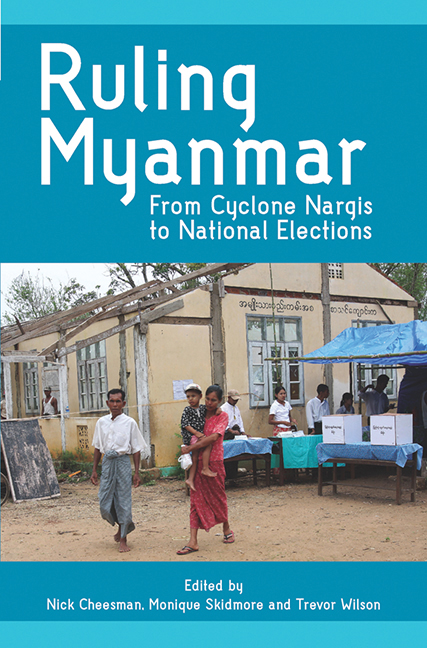Book contents
- Frontmatter
- Contents
- List of Tables
- List of Figures
- Background on ANU 2009 Myanmar/Burma Update Conference
- Acknowledgements
- Contributors and Editors
- Note on Terminology and Geographical Names
- Map of Myanmar
- Part I Overview
- Part II Political Legitimacy, Governance and Justice
- Part III Economic Development, the Rural Economy and Labour Rights
- Part IV The Role of International Cooperation and Governance
- 11 Cyclone Nargis and ASEAN: A Window for More Meaningful Development Cooperation in Myanmar
- 12 The Relief and Reconstruction Programme Following Cyclone Nargis: A Review of SPDC Policy
- 13 Positive Engagement in Myanmar: Some Current Examples and Thoughts for the Future
- 14 Normative Europe meets the Burmese Garrison State: Processes, Policies, Blockages and Future Possibilities
- 15 The Use of Normative Processes in Achieving Behaviour Change by the Regime in Myanmar
- List of Abbreviations
- Index
13 - Positive Engagement in Myanmar: Some Current Examples and Thoughts for the Future
from Part IV - The Role of International Cooperation and Governance
Published online by Cambridge University Press: 21 October 2015
- Frontmatter
- Contents
- List of Tables
- List of Figures
- Background on ANU 2009 Myanmar/Burma Update Conference
- Acknowledgements
- Contributors and Editors
- Note on Terminology and Geographical Names
- Map of Myanmar
- Part I Overview
- Part II Political Legitimacy, Governance and Justice
- Part III Economic Development, the Rural Economy and Labour Rights
- Part IV The Role of International Cooperation and Governance
- 11 Cyclone Nargis and ASEAN: A Window for More Meaningful Development Cooperation in Myanmar
- 12 The Relief and Reconstruction Programme Following Cyclone Nargis: A Review of SPDC Policy
- 13 Positive Engagement in Myanmar: Some Current Examples and Thoughts for the Future
- 14 Normative Europe meets the Burmese Garrison State: Processes, Policies, Blockages and Future Possibilities
- 15 The Use of Normative Processes in Achieving Behaviour Change by the Regime in Myanmar
- List of Abbreviations
- Index
Summary
INTRODUCTION
Myanmar approaches 2010 with only a few areas of certainty — one being that external observers will differ in the many possible interpretations of the events and process in the lead-up to the election, and another that there will be many dissatisfied with the result, regardless of the process. The new constitution offers potential opportunities for change and improvement in Myanmar, but various aspects of the transition are still unclear, yet critical for stability. Given the conflicting views, the process of change should be gradual.
National development goals are diverse. The consideration of this diversity should be coupled with the understanding that the Myanmar government is not monolithic, as often portrayed, and that at times a surprising mix of approaches is shown in methodology. Myanmar is a country of enormous richness and variety, and home to many groups characterized by great resilience, courage and a passion for national development.
Myanmar has rarely received positive press, or commendation for work done well, despite a considerable amount of progress that has taken place. A flow on from this has been more negativity in foreign policy or attitudes than is appropriate for the context. Failure to recognize progress for what it is devalues the efforts of a host of people working hard to create change in many ways. Yet few news reports or studies are written on positive achievements, although it can be expected that an increasing number of diverse, positive case studies will emerge as more summaries of accounts of work done as part of the overall response to Cyclone Nargis accumulate. The December 2008 edition of Humanitarian Exchange, published by the Overseas Development Institute, included a number of these. In general, as reporting on Nargis-related activities has been far better publicized than other examples, this chapter will seek to draw on other lesser-known examples. It acknowledges the many criticisms made of complex issues in Myanmar and makes no attempt to refute them, or to add to the shortcomings detailed elsewhere. The main purpose is to present some more positive and lesser-known perspectives on progress in Myanmar as alternatives that can be built on as a means of offering different pathways to future national development.
- Type
- Chapter
- Information
- Ruling MyanmarFrom Cyclone Nargis to National Elections, pp. 236 - 266Publisher: ISEAS–Yusof Ishak InstitutePrint publication year: 2010



